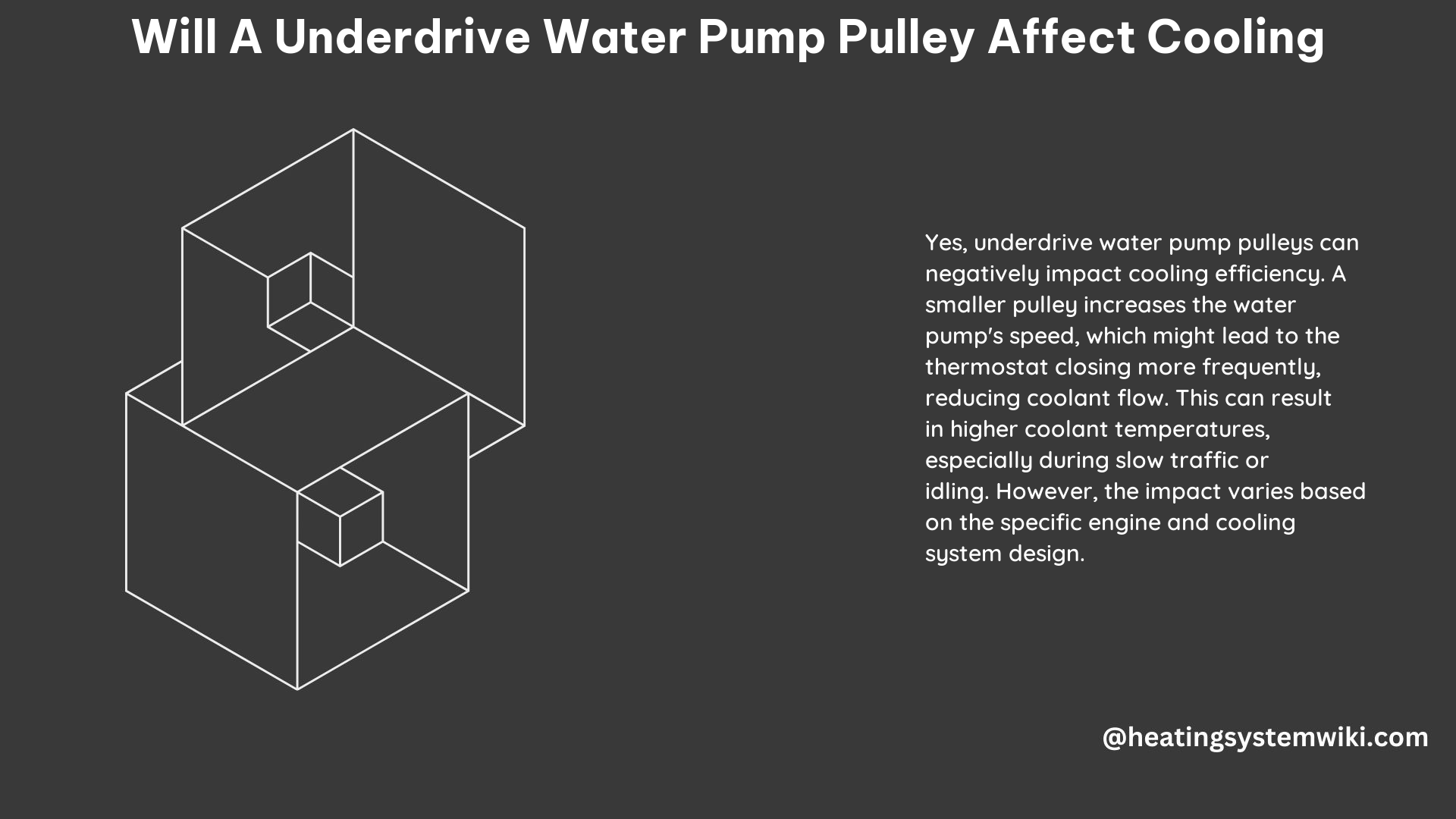An underdrive water pump pulley can affect cooling in various ways, primarily by changing the speed of the water pump. This can lead to changes in coolant flow and temperature, which can have both positive and negative effects on cooling efficiency.
Understanding the Impact of Underdrive Water Pump Pulleys on Cooling
The speed of the water pump is a critical factor in maintaining optimal cooling efficiency. An underdrive water pump pulley can reduce the speed of the water pump, which can lead to several consequences:
-
Reduced Coolant Flow: When the water pump speed is reduced, the volume of coolant circulating through the engine and radiator decreases. This can result in less efficient heat transfer, leading to higher engine temperatures.
-
Thermostat Behavior: With a slower water pump, the thermostat may not open as quickly or as fully, as it is designed to regulate coolant flow based on temperature. This can cause the coolant to circulate more slowly, further exacerbating the cooling issues.
-
Uneven Cooling: The reduced coolant flow can lead to uneven cooling, with some areas of the engine experiencing higher temperatures than others. This can cause hot spots and potentially lead to premature wear or damage.
-
Increased Cavitation: At lower water pump speeds, the risk of cavitation (the formation of vapor bubbles in the coolant) increases. Cavitation can cause damage to the water pump impeller and other cooling system components.
Potential Benefits of Underdrive Water Pump Pulleys

While the primary concern with underdrive water pump pulleys is the potential for cooling issues, there are some potential benefits that users have reported:
-
Reduced Parasitic Drag: By reducing the speed of the water pump, the engine no longer has to work as hard to drive the pump, which can result in a slight increase in engine efficiency and power output.
-
Improved Fuel Economy: The reduced parasitic drag from the water pump can lead to a small improvement in fuel economy, particularly in high-performance applications where the water pump is a significant load on the engine.
-
Reduced Noise and Vibration: A slower-spinning water pump can generate less noise and vibration, which may be desirable in some applications.
Factors to Consider When Installing an Underdrive Water Pump Pulley
When considering the installation of an underdrive water pump pulley, it is essential to carefully evaluate the specific application and potential drawbacks:
-
Engine and Cooling System Design: The impact of an underdrive pulley will depend on the engine’s design, the cooling system’s capacity, and the specific operating conditions. What may work well in one application may not be suitable for another.
-
Thermostat Selection: Adjusting the thermostat’s temperature rating may be necessary to maintain optimal coolant flow and temperature when using an underdrive pulley.
-
Fan Operation: The engine’s cooling fan may need to be adjusted or upgraded to ensure sufficient airflow through the radiator, especially at lower water pump speeds.
-
Coolant Flow Monitoring: Regular monitoring of coolant levels, temperatures, and flow rates can help identify any issues and allow for timely adjustments to the cooling system.
-
Potential for Overheating: In some cases, an underdrive pulley may lead to excessive engine temperatures, particularly under high-load or high-speed conditions. This can result in reduced engine performance and potentially cause damage.
Technical Specifications and Considerations
When selecting an underdrive water pump pulley, it is essential to consider the following technical specifications and factors:
-
Pulley Diameter Reduction: The degree of underdrive, typically expressed as a percentage, can range from around 10% to 20% or more. A larger reduction in pulley diameter will result in a greater decrease in water pump speed.
-
Coolant Flow Rate: The reduction in water pump speed can lead to a decrease in coolant flow rate, which can be measured in gallons per minute (GPM) or liters per minute (LPM). The specific impact will depend on the engine and cooling system design.
-
Coolant Temperature: The changes in coolant flow can affect the overall coolant temperature, which should be monitored to ensure it remains within the manufacturer’s recommended range.
-
Thermostat Compatibility: Ensure that the thermostat used is compatible with the reduced coolant flow and can still effectively regulate the coolant temperature.
-
Cavitation Risk: The risk of cavitation increases at lower water pump speeds, which can lead to impeller and component damage. Monitoring for signs of cavitation is essential.
-
Radiator and Fan Capacity: Ensure that the radiator and cooling fan are capable of dissipating the engine’s heat load, even with the reduced coolant flow from the underdrive pulley.
DIY Installation and Maintenance Tips
When installing an underdrive water pump pulley, it is crucial to follow these DIY tips:
-
Carefully Measure and Select the Appropriate Pulley: Ensure that the new pulley diameter is compatible with your engine and cooling system requirements.
-
Bleed the Cooling System Thoroughly: After installation, bleed the cooling system to remove any air pockets that could impede coolant flow.
-
Monitor Coolant Levels and Temperatures: Regularly check the coolant level and temperature to ensure the cooling system is functioning as expected.
-
Adjust Thermostat and Fan Settings as Needed: Be prepared to adjust the thermostat or fan settings to maintain optimal cooling efficiency.
-
Perform Regular Maintenance: Regularly flush the cooling system, replace the coolant, and inspect the water pump and other components for any signs of wear or damage.
By following these guidelines and carefully considering the technical specifications and potential drawbacks, you can successfully install an underdrive water pump pulley and maintain optimal cooling performance in your vehicle.
